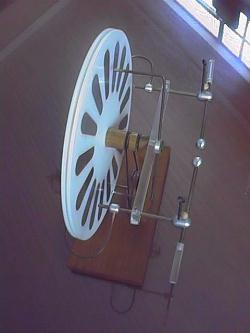A Lebiez machine (simplified Voss machine)
 This influence machine is another variation of the Holtz
machine (1865). It can be also considered as a simplified version of the
Voss machine (1880).
In my version (left), it consists in a rotating
disk made of insulating material (acrylic) with an even number of metallic
tabs glued to it, exactly as the disks of a Wimshurst machine,
that rotates in front of a another, fixed, disk with two insulated metallic
plates (inductors) glued to it, covering
90 degrees each. These
metallic plates make contact with the tabs on the rotating disk
through two brushes at horizontal diametrically opposite positions,
and to the machine terminals. A neutralizer wire with brushes, as
the ones in a Wimshurst machine, connects opposite tabs in the
rotating disk as they leave the influence of the inductor plates.
This influence machine is another variation of the Holtz
machine (1865). It can be also considered as a simplified version of the
Voss machine (1880).
In my version (left), it consists in a rotating
disk made of insulating material (acrylic) with an even number of metallic
tabs glued to it, exactly as the disks of a Wimshurst machine,
that rotates in front of a another, fixed, disk with two insulated metallic
plates (inductors) glued to it, covering
90 degrees each. These
metallic plates make contact with the tabs on the rotating disk
through two brushes at horizontal diametrically opposite positions,
and to the machine terminals. A neutralizer wire with brushes, as
the ones in a Wimshurst machine, connects opposite tabs in the
rotating disk as they leave the influence of the inductor plates.
The machine takes the output directly from
the inductor plates,
differing in this aspect from the Holtz and Voss machines. In this
configuration it is similar to a simple bipolar
"doubler" machine as the Belli machine, Lord Kelvin's "replenisher", or
a Dirod machine.
A machine with the practically the same structure was described
by M. L. Lebiez in L'Électricien, April 1895, pp. 225-227
[p31].
With nice pictures. Front, plan,
and schematic (rather poor images).
I used acrylic disks, with metal sectors and inductors made of
aluminum foil tightly glued to the disks. The metal connections
were made with brass wire 2 and 3 mm thick and aluminum balls. The
structure was made of wood and the insulator holding the terminal
assemblies of acrylic.
This machine is a little less efficient than a Wimshurst
machine, but it self-starts more easily. Its main problem are
periodic polarity reversals, due to the fixed inductors. If they
are glued in just one side of the fixed disk (the outer side),
opposite charge quickly accumulates in the other side of the
disk, reducing the electric field and the induction over the
rotating disk. At the first spark through the terminals, or just
after a speed reduction, the inductors discharge, and the charge
in the opposite side of the fixed disk makes the machine start
again with the opposite polarity. The process repeats, with a
polarity inversion after each spark (specially if Leyden jars are
attached to the terminals). This problem can be solved
by gluing connected metal plates to both sides of the fixed disk.
But then, there is a serious loss of charge by small sparks from
the inductors in the inner side of the fixed disk to the rotating
disk, that transport by the rotation charge from one inductor to
the other. The Voss machine minimizes
this problem by separating the output circuit from the inductor
plates. The structure of the Wimshurst machine
cleverly avoids the problem of charge buildup
in the opposite side of the inductors, by changing the polarity
of the inductors twice at each turn.
Note that this machine can easily be built with plastic tubes
instead of disks, what is difficult with the Wimshurst machine.
Created: 1996.
Last update: 29 December 2006
Antonio Carlos M. de Queiroz
http://www.coe.ufrj.br/~acmq
Return to Electrostatic Machines
 This influence machine is another variation of the Holtz
machine (1865). It can be also considered as a simplified version of the
Voss machine (1880).
In my version (left), it consists in a rotating
disk made of insulating material (acrylic) with an even number of metallic
tabs glued to it, exactly as the disks of a Wimshurst machine,
that rotates in front of a another, fixed, disk with two insulated metallic
plates (inductors) glued to it, covering
90 degrees each. These
metallic plates make contact with the tabs on the rotating disk
through two brushes at horizontal diametrically opposite positions,
and to the machine terminals. A neutralizer wire with brushes, as
the ones in a Wimshurst machine, connects opposite tabs in the
rotating disk as they leave the influence of the inductor plates.
This influence machine is another variation of the Holtz
machine (1865). It can be also considered as a simplified version of the
Voss machine (1880).
In my version (left), it consists in a rotating
disk made of insulating material (acrylic) with an even number of metallic
tabs glued to it, exactly as the disks of a Wimshurst machine,
that rotates in front of a another, fixed, disk with two insulated metallic
plates (inductors) glued to it, covering
90 degrees each. These
metallic plates make contact with the tabs on the rotating disk
through two brushes at horizontal diametrically opposite positions,
and to the machine terminals. A neutralizer wire with brushes, as
the ones in a Wimshurst machine, connects opposite tabs in the
rotating disk as they leave the influence of the inductor plates.